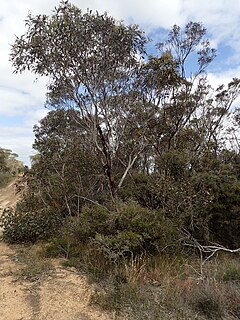Eucalyptus zopherophloia, commonly known as the blackbutt mallee, is a species of spreading mallee that is endemic to an area on the west coast of Western Australia. It has rough bark over part or all of the trunk, smooth grey bark above, narrow lance-shaped leaves, flower buds in groups of nine or eleven, creamy white flowers and conical fruit.

Eucalyptus deflexa, commonly known as Lake King mallee, is a species of mallee that is endemic to Western Australia. It has smooth grey to whitish bark, linear to elliptic or curved adult leaves, pendulous flower buds arranged in groups of seven, cream-coloured or pink flowers and pendulous barrel-shaped fruit.
Eucalyptus famelica is a species of mallee that is endemic to Western Australia. It has smooth grey and pale brown bark, sometimes with thin, rough, fibrous bark near the base of the trunk on larger plants. The adult leaves are lance-shaped, the flower buds are arranged in groups of seven, the flowers are creamy white and the fruit is cup-shaped to cylindrical.

Eucalyptus georgei, commonly known as Hyden blue gum, is a species of tree or mallet that is endemic to Western Australia. It has smooth bark, glossy green, lance-shaped adult leaves, glaucous flower buds in groups of between seven and eleven, creamy white flowers and conical to cup-shaped fruit.

Eucalyptus hebetifolia is a species of mallee that is endemic to southern Western Australia. It has smooth grey and brownish bark with loose ribbons of bark near the base, lance-shaped adult leaves, flower buds in groups of up to thirteen, creamy white flowers and conical to barrel-shaped fruit.
Eucalyptus kumarlensis is a species of tree that is endemic to a restricted area of Western Australia. It has smooth bark, linear to narrow, curved adult leaves, flower buds in groups of seven, nine or eleven, creamy white flowers and cup-shaped, conical or hemispherical fruit.

Eucalyptus latens, commonly known as narrow-leaved red mallee, is a species of mallee that is endemic to the south-west of Western Australia. It has smooth grey and coppery bark, linear to narrow lance-shaped adult leaves, flower buds in groups of seven to eleven or more, creamy white flowers and small barrel-shaped to shortened spherical fruit.
Eucalyptus livida, commonly known as wandoo mallee, is a species of mallee or small tree that is endemic to Western Australia. It has smooth bark, lance-shaped adult leaves, flower buds in groups of eleven or more, creamy white flowers and barrel-shaped fruit.
Eucalyptus microschema is a species of small, shrubby mallee that is endemic to the southwest of Western Australia. It has smooth, silvery grey bark, linear adult leaves, flower buds in groups of nine or eleven, white flowers and short, barrel-shaped fruit. It is restricted to a small area near Newdegate.

Eucalyptus nutans, commonly known as red-flowered moort, is a species of mallet that is endemic to a small area near the south coast of Western Australia. It has smooth bark, oblong to almost round adult leaves, flower buds in groups of seven, red or pinkish flowers and cup-shaped to conical fruit.
Eucalyptus olivina is a species of mallee or a tree that is endemic to Western Australia. It has smooth greyish bark, linear to narrow lance-shaped adult leaves, flower buds in groups of seven or nine, creamy white flowers and short barrel-shaped to cup-shaped fruit.

Eucalyptus phaenophylla, also known as common southern mallee, is a species of mallee that is endemic to Western Australia. It has smooth bark, linear to narrow lance-shaped or narrow elliptical adult leaves, flower buds in groups of up to thirteen, pale lemon-coloured flowers and barrel-shaped, cylindrical or conical fruit.
Eucalyptus praetermissa is a species of mallet that is endemic to a small area on the south coast of Western Australia. It has smooth bark, lance-shaped adult leaves, flower buds in groups of up to fifteen, creamy white to pale yellow flowers and cylindrical to barrel-shaped fruit.

Eucalyptus sporadica, commonly known as the Burngup mallee, is a species of mallee that is endemic to the southwest of Western Australia. It has smooth bark, lance-shaped adult leaves, flower buds in groups of seven, yellowish flowers and down-turned, conical to cylindrical fruit.
Eucalyptus thamnoides is a species of mallee that is endemic to south western Western Australia. It has smooth bark, lance-shaped adult leaves, flower buds in groups of seven, cream-coloured to pale yellow flowers and cup-shaped, conical or bell-shaped fruit.
Eucalyptus vegrandis, commonly known as the Ongerup mallee, is a species of mallee that is endemic to the south-west of Western Australia. It has smooth bark, linear to lance-shaped adult leaves, flower buds in groups of seven, creamy white flowers and cup-shaped or conical fruit.

Eucalyptus captiosa is a species of mallee that is endemic to the south-west of Western Australia. It has smooth bark, lance-shaped adult leaves, groups of three or seven, slightly ribbed flower buds arranged in leaf axils, pale yellow flowers and cup shaped fruit.

Eucalyptus chlorophylla, commonly known as green-leaf box, northern glossy-leaved box or glossy-leaved box, is a species of eucalypt that is endemic to northern Australia. It is a tree or mallee, with hard, rough bark, lance-shaped or curved adult leaves, flower buds in groups of seven, creamy white flowers and usually conical fruit.
Eucalyptus cuprea, commonly known as the mallee box, is a species of mallee that is endemic to the west coast of Western Australia. It has rough, flaky bark on the base of its trunk, smooth coppery-coloured bark above, lance-shaped adult leaves, flower buds in groups of seven, creamy white flowers and conical to cup-shaped fruit.
Eucalyptus opimiflora, commonly known as northern silver mallee, is a species of mallee that is endemic to near-coastal areas of Western Australia between Perth and Geraldton. It has smooth grey bark, lance-shaped adult leaves, flower buds in groups of between seven and fifteen, creamy white flowers and conical to hemispherical fruit.









